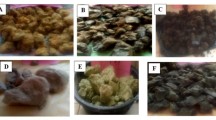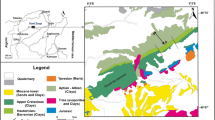Abstract
The Wadi Badaa (WB) Upper Miocene clays, Cairo-Suez district, Egypt, represent materials for the ceramic production. The clay raw materials are composed mainly of smectite and kaolinite with minor quartz, calcite, and rare feldspar. The plasticity indices vary between 24 and 30%, suggesting that these clays are plastic raw materials. IR bands of the investigated clays were observed at 3695, 3619, 1032, 916, 794, 690, 534, 466, and 423 cm−1 for kaolinite; at 3436, 1635, 916, and 466 cm−1 for smectite; and at 1179, 1104, 794, 690, and 466 cm−1 for quartz. The <2 μm particle sizes of samples are relatively abundant in clays (∼33%), which is adequate for uses of the ceramic products because of containing fine particle sizes. The studied WB clays contain 7.95 and 12.35% moisture water and interlayer water, respectively, with a maximum drying shrinkage of 7.87% at room temperature; therefore, the WB clays could be used in the ceramic manufacture.





Similar content being viewed by others
References
Abdallah AM, Abdel Hady FM (1966) Geology of Sadat area. Gulf of Suez Egy J Geol 10:1–22
Ambikadevi VR, Lalithambika M (2000) Effect of organic acids on ferric iron removal from iron-stained kaolinite. Applied Clay Sci 16:133–145
Andráš P, Dirner V, Kharbish S, Krnáč J (2013a) Characteristics of heavy metal distribution at spoil dump-fields of cu-deposit Ľubietová (Slovakia). Carpath J Earth Env Sci 8:87–96
Andráš P, Turisová I, Lacková E, Kharbish S, Krnáč J, Čmielová L (2013b) Environmental risk due to heavy metal contamination caused by old copper mining activity at Ľubietová deposit, Slovakia. Energ Env Res 3:182–197
Arsenović MV, Pezo LL, Radojević ZM, Stanković SM (2013) Serbian heavy clays behavior: application in rough ceramics. Hem Ind 67:811–822
Bergaya, F., Theng, B.K.G., Lagaly, G. (Eds.), 2006. Handbook of Clay Science. Elsevier, Developments of Clay Science, Volume 1, AmsterdamBrown, G., Brindley, G.W., 1984. Crystal Structures of Clay Minerals and their X-ray Identification. Mineralogical Society, London
Biscaye PE (1965) Mineralogy and sedimentation of recent deep-sea clay in the Atlantic Ocean and adjacent seas and oceans. Geological Society American Bulletin 76:803–832
Brown G, Brindley GW (1984) Crystal Structures of clay minerals and their X-ray Identification. Mineralogical Society, London
Carretero MI, Dondi M, Fabbri B, Raimondo M (2012) The influence of shaping and firing technology on ceramic properties of calcareous and non-calcareous illitic–chloritic clays. Appl Clay Sci 20/6:301–306
Carver RE (1971) Procedures in sedimentary petrology. John Wiley and Sons, New York
Casagrande A (1948) Classification and Identification of soils. Transaction ASCE 113:901–930
Chester R, Green RN (1968) The infrared determination of quartz in sediments and sedimentary rocks. Chem Geol 3:199–213
Christidis GE (2011) Industrial clays. In: Christidis GE (ed) Advances in the characterization of industrial minerals, EMU notes in mineralogy, vol 9. European Mineralogical Union and the Mineralogical Society of Great Britain, London, pp 341–414 (Chapter 9)
Daskshama V, Mohan BV, Lalithambika M, Nair CGR (1992) Sintering studies on plastic clays. Ceram Int 18:359–364
De Mesquita LMS, Rodrigues T, Gomes SS (1996) Bleaching of Brazilian kaolins using organic acids and fermented medium. Miner Eng 9:965–971
Dondi M, Fabbri B, Guarini G (1998) Grain-size distribution of Italian raw materials for building clay products: a reappraisal of the Winkler diagram. Clay Miner 33:435–442
Dondi M, Guarini G, Ligas P, Palomba M, Raimondo M (2001) Chemical, mineralogical and ceramic properties of kaolinitic materials from the Tresnuraghes mining district. Western Sardinia, Italy. Appl. Clay Sci 18:145–155
Dondi M, Raimondo M, Zanelli C (2014) Clays and bodies for ceramic tiles: reappraisal and technological classification. Appl Clay Sci 96:91–109
El-Azabi, N.H., 2000. Sedimentary facies, palaeoenvironments and facies development of the Miocene–Pliocene sequence in the Sadat–Wadi Hagul stretch, northwest Gulf of Suez and their time correlatives in the adjacent basins, Egypt. In: 5th International Conference on the Geology of the Arab World, Cairo University, Egypt, pp. 1135–1174
El-Fadaly E (2013) Characterization of porcelain stoneware tiles based on solid ceramic wastes. IJSR 4:602–608
Farmer VC (1974) The infrared spectra of minerals. Mineralogical Society, London
Folk RL (2014) Petrology of sedimentary rocks. Hemphills Publ. Co, Austin, Texas
Friedman GM, Sanders JE (1978) Principles of sedimentology. Wiley, New York
Galos K (2011) Composition and ceramic properties of ball clays for porcelain stoneware tiles manufacture in Poland. Appl Clay Sci 51:74–85
Gámiz E, Melgosa M, Sánchez-Maranňón M, Martín-García JM, Delgado R (2005) Relationships between chemico-mineralogical composition and color properties in selected natural and calcined Spanish kaolins. Appli Clay Sci 28:269–282
Grim RE (1980) Clay mineralogy, 2nd edn. Mc Graw Hill Book Comp., Inc., New York, Toronto, London
Hammami-Ben Zaied F, Abidi R, Slim-Shimi N, Somarin AK (2015) Potentiality of clay raw materials from grain the ceramic industry. Appl Clay Sci 112(113):1–9
Hlavay J, Jonas K, Elek S, Inczedy J (1978) Characterization of the particle size and the crystallinity of certain minerals by IR spectrophotometry and other instrumental methods; II, investigations on quartz and feldspar. Clay Clay Miner 26:139–143
Holtz RD, Kovacs WD (1981) An introduction to geotechnical engineering. Prentice-Hall, Englewood Cliffs, NJ
Ismael SI, Kharbish S (2013) Removing of as (V) from aqueous solution using natural and pretreated glauconite and halloysite. Carpath J Earth Env Sci 8:187–198
Jordan MM, Sanfeliu T, De la Fuente C (2001) Firing transformations of tertiary clays used in the manufacturing of ceramic tile bodies. Appl Clay Sci 20:87–95
Jouenne CA (1990a) Traite de ceramiques et materiaux mineraux. Septima, Paris
Kara A, Stevens R (2002) Characterization of biscuit fired bone china body microstructure. Part I: XRD and SEM of crystalline phases. J Eur Ceram Soc 22:731–736
Khalaf FI, Gaber AS (2008) Occurrence of cyclic palustrine and calcrete deposits within the lower Pliocene Hagul formation, East Cairo district, Egypt. J Afr Earth Sci 51:298–312
Konta, J., 1981. Properties of Ceramic Raw Materials. Ceramic Monographs, Handbook of Ceramics, Monograph 1.1.4, Interceram, 30, Nos. 1–2, 5–10, Verlag Schmid GmbH, Freiburg i. Brg
Krumbien WC, Pettijohn FJ (1988) Manual of sedimentary petrography. D. Appleton-century, New York
Ma HZ, Wang B (2006) Multifunctional micro size modified kaolin and its application in wastewater treatment. J Hazard Mater 136:365–370
Madejová J, Komadel P (2001) Baseline studies of the clay minerals source society: infrared methods. Clay Clay Miner 49:410–432
Manning DAC (1995) Introduction to industrial mineral. Chapman & Hall, London , p 275ppEdition
Milheiro FAC, Freire MN, Silva AGP, Holanda JNF (2005) Densification behaviour of a red firing Brazilian Kaolinitic clay. Ceram Int 31:757–763
Modesto C, Bernardin AM (2008) Determination of clay plasticity: indentation method versus Pfefferkorn method. Appl Clay Sci 40:15–19
Moore DM, Reynolds RC Jr (1989) X-ray diffraction and the Identification and analysis of clay minerals. Oxford University Press, Oxford, p 332pp
Murray, H.H., 2007. Applied Clay Mineralogy: Occurrences, Processing and Application of Kaolins, Bentonites, Palygorskite-Sepiolite, and Common Clays. Elsevier, Developments in Clay Science, (Volume 2)
Mycielska-Dowgiałło E, Ludwikowska-Kędzia M (2011) Alternative interpretation of grain-size data from quaternary deposits. Andean Geol 17:189–203
Nesbitt HW, Young GM (1982) Early Proterozoic climates and plate motions inferred from major element chemistry of lutites. Nature 299:715–717
Nesbitt HW, Young GM (1984) Prediction of some weathering trends of plutonic and volcanic rocks based on thermodynamic and kinetic considerations. Geochim Cosmochim Acta 48:1523–1534
Nesbitt HW, Young GM, McLennan SM, Keays RR (1996) Effects of chemical weathering and sorting on the Petrogenesis of siliciclastic sediments with implications for provenance studies. J Geol 104:525–542
Ngun BK, Mohamad H, Sulaiman SK, Okada K, Ahmad ZA (2011) Some ceramic properties of clays from central Cambodia. Appl Clay Sci 53:33–41
Piltz G (1964) Untersuchung der Möglichkeiten der Aufhellung der Brennfarben von Ziegelrohstoffen, Westdt. Verl, Köln
Proust C, Jullien A, Forestier L (2004) Determination indirecte des limites d'Atterberg par gravimétrie dynamique. Compt Rendus Geosci 335:175–183
Riley CH (1951) Relation of chemical properties to the bloating of clays. J Am Ceram Soc 34:121–128
Ritz M, Vaculíková L, Plevová E (2011) Application of infrared spectroscopy and Chemometric methods to Identification of selected minerals. Acta Geodyn Geomater 8:47–58
Russell JD, Fraser AR (1994) Infrared methods. In: Wilson MJ (ed) Clay mineralogy: spectroscopic and chemical determinative methods. Chapman & Hall, London, pp 11–67 (Chapter 2)
Ryan W (1979) Properties of ceramics raw material. Pergamon Press, Oxford
Seleem TA, Aboulela HA (2011) Seismicity and geologic Structures indubitable in Wadi Hagul, north Eastern Desert, Egypt. Int J Geosci 2:55–67
Tosca NJ, David TJ, Alexandra AM, Daniel HR, Roger ES, Andrew HK (2010) Clay mineralogy, organic carbon burial, and redox evolution in Proterozoic oceans. Geochim Cosmochim Acta 74(5):1579–1592
Vaculíková L, Plevová E (2005) Identification of clay minerals and micas in sedimentary rocks. Acta Geodyn Geomater 2:167–175
Van Jaarsveld JGS, Van Deventer JSJ, Lukey GC (2012) The effect of composition and temperature on the properties of fly ash- and kaolinite-based geopolymers. Chem Eng J 89:63–73
Vantelon D, Pelletier M, Barres O, Thomas F, Michot LJ (2001) Fe, mg and al distribution in the octahedral sheet of montmorillonites. An infrared study in the OH-bending region. Clay Miner 36:369–379
Veglio F, Passarielo B, Toro L, Marabini AM (1996) Development of a bleaching process for a kaolin of industrial interest by oxalic, ascorbic, and sulfuric acids: preliminary study using statistical methods of experimental design. Ind Eng Chem Res 35:1680–1687
Vimonses V, Lei S, Jin B, Chow CWK, Saint C (2009) Adsorption of Congo red by three Australian kaolins. Appli Clay Sci 43(465):472
Winkler HGF (1954) Bedeutung der Korngrößenverteilung und des Mineralbestandes von Tonen für die Herstellung grobkeramischer Erzeugnisse. Berichte der Deutschen Keramischen Gesellschaft 31:337–343
Yanik G, Ceylantekin R, Taşçi E, Özçay Ü (2012) The Şahin village (Kütahya, Turkey) clay deposit and its possible utilization. Clay Miner 47:1–10
Acknowledgments
The authors are grateful to Prof. Dr. Abdullah M. Al-Amri Editor-in-Chief Arabian Journal of Geosciences and for the Associate Editor Prof. Dr. Mehmet Sabri Çelik for their kind help. Thanks are also due to two anonymous reviewers for their valuable comments that helped to improve the manuscript.
Author information
Authors and Affiliations
Corresponding author
Ethics declarations
Conflict of interest
The authors declare that they have no conflict of interest.
Rights and permissions
About this article
Cite this article
Kharbish, S., Farhat, H.I. Mineralogy and physico-chemical properties of Wadi Badaa clays (Cairo-Suez district, Egypt): a prospective resource for the ceramics industry. Arab J Geosci 10, 174 (2017). https://doi.org/10.1007/s12517-017-2969-1
Received:
Accepted:
Published:
DOI: https://doi.org/10.1007/s12517-017-2969-1




